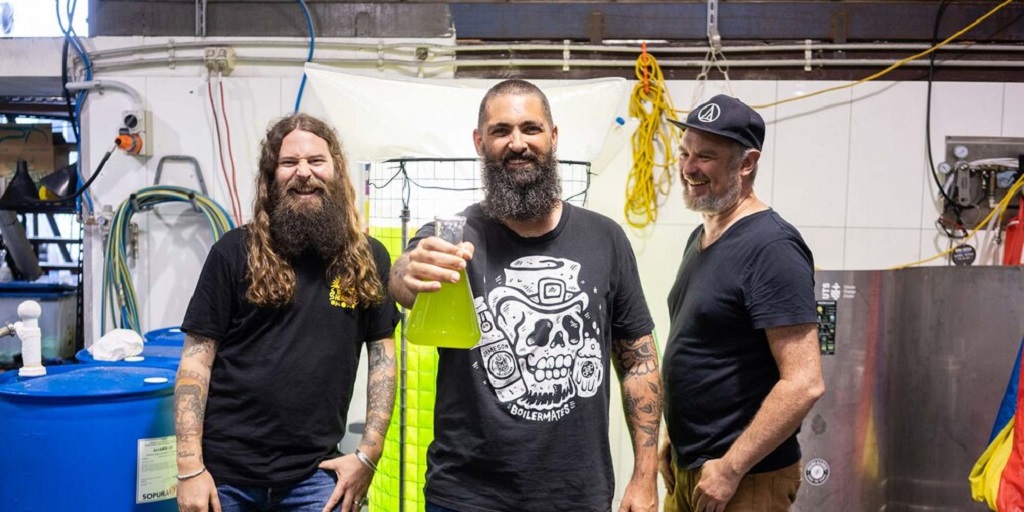
Young Henrys takes algae project to the next level

Young Henrys made international headlines when it launched its algae project with the aim of reducing CO2 waste in the brewery, and it is now taking the project to the next level.
Initially launched in 2018, the research project intended to determine if algae could grow in a brewing environment and digest the CO2 expelled in the fermentation process, which would otherwise go to waste.
The Sydney brewery brought two 400-litre bioreactors into its Newtown site to help capture the CO2 and release oxygen in the process.
Now, phase two of the project is being launched in conjunction with the University of Technology Sydney Climate Change Cluster and Meat & Livestock Australia.
This next phase aims to determine use cases for the algae grown at the Newtown brewery. It will investigate how different algal species can reduce the methane output of livestock, a process called methanogenesis.
Young Henrys will help cultivate a variety of algal species, which will be used in smaller scale lab tests to monitor their effect on a cow’s digestion and methane output, which is considered one of the major emissions in agriculture and a huge contributor to global greenhouse gas emissions.
“This was the goal from the outset,” explained Richard Adamson, director at Young Henrys.
“When we saw algae in action and understood a bit more about it, we found that it is like yeast but does the opposite job. So can we have these two things in balance?
“We managed to sequester the CO2 and grow algae, but the big question was, ‘what we do with algae after?’”
Algae has been used in a multitude of industries and products from food and clothing to face creams, pigments and plastic.
The team at UTS have already been testing Australian algal strains and have been met with “promising results” so the next stage will be to test correct algal strains and the right dosage for livestock for maximum methane production while keeping the cattle healthy.
“What we’ve been looking at is ticking a whole bunch of boxes. Can it handle a high CO2 environment? Will it be palatable and digestible by cattle? And will it do the reduction job effectively?
“We’ve been getting into that nitty gritty and testing with livestock after seeing what it does in the lab.
“With the help of MLA, we’ll do some further lab testing so we’ll be able to cast the net a lot wider, using different algae strains within the ones we’ve done.
“We want to get the super algae to tick all those boxes. It will be tried on lambs, because lambs need less feed, then cattle, so we can then scale that up and give that biomass to feed the livestock as well.”
Algae and livestock
Investigations into seaweed or macroalgae and its effect on cattle digestion and methane production are already well underway in the Australian livestock market, although there have been some concerns about the effect of a diet consisting of algae on the cattle’s digestion and health, which is something the UTS team will be looking at closely.
“It’s complex because what you’re doing is suppressing one set of bacteria in the rumen that produces methane, so you need to have a balanced biome of the rumen.
“You can’t have it go completely out of whack, because it affects the digestive health of the cattle. So it needs to be that it reduces methane but keeps digestibility.
“Then it’s also about what the taste of the beef and milk is like. Ultimately it should be that by reducing methane when it comes out of that digestion, it’s more impactful, and they put on weight quicker. That should be the result, but it’s not that simple.”
The Young Henrys and UTS teams are hoping to create further links between brewing and the livestock industries, considering Young Henrys and many other breweries already sell spent grain to farmers as livestock feed.
The project will also aid the livestock industry, which has signed on to an ambitious target of being carbon neutral by 2030.
Phase three will begin from 2022, and will involve further livestock trials and investigate the scalability of algae dosing in cows.
Having committed long-term to the project, Young Henrys’ brewers have become adept in the nurture of algae.
“That’s the really exciting part, once people understood, everyone jumped on board,” Adamson said.
“It’s extra work for the brewers but they understand the importance of what we’re doing and what it could contribute so they are happy to look after the algae as well as everything else! They’ve become quite expert at it.”
With suggestions that there are up to 15 grams of CO2 produced for every pint of beer brewed, CO2 emissions are a major issue in the brewing industry.
It has led brewers of all sizes to look at their emissions, with some investing in small scale projects like Terella’s which aims to help feed plants with CO2 from the brewery, to major projects like BrewDog’s aim to plant 1 million trees over the next few years to offset its own carbon emissions.
Adamson said that Young Henrys wanted to help develop a solution which benefits both the brewing industry and farmers with their emissions.
“Behind the scenes there’s been a lot of interest, people coming to us asking ‘what exactly are you doing?’
“Breweries around the world want to get involved and ultimately if we’re having an impact on the environment we need other breweries to take it up, and if this yields positive results, we want more breweries doing it.”



